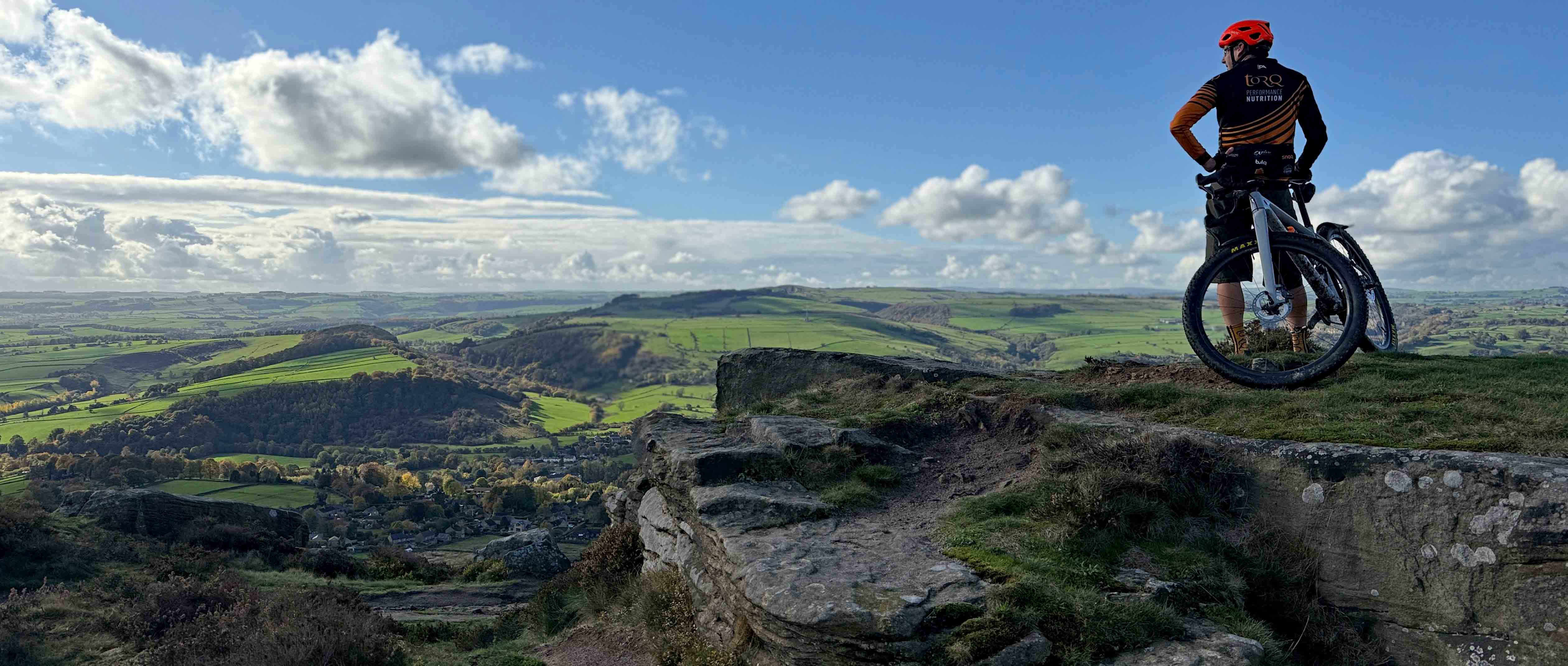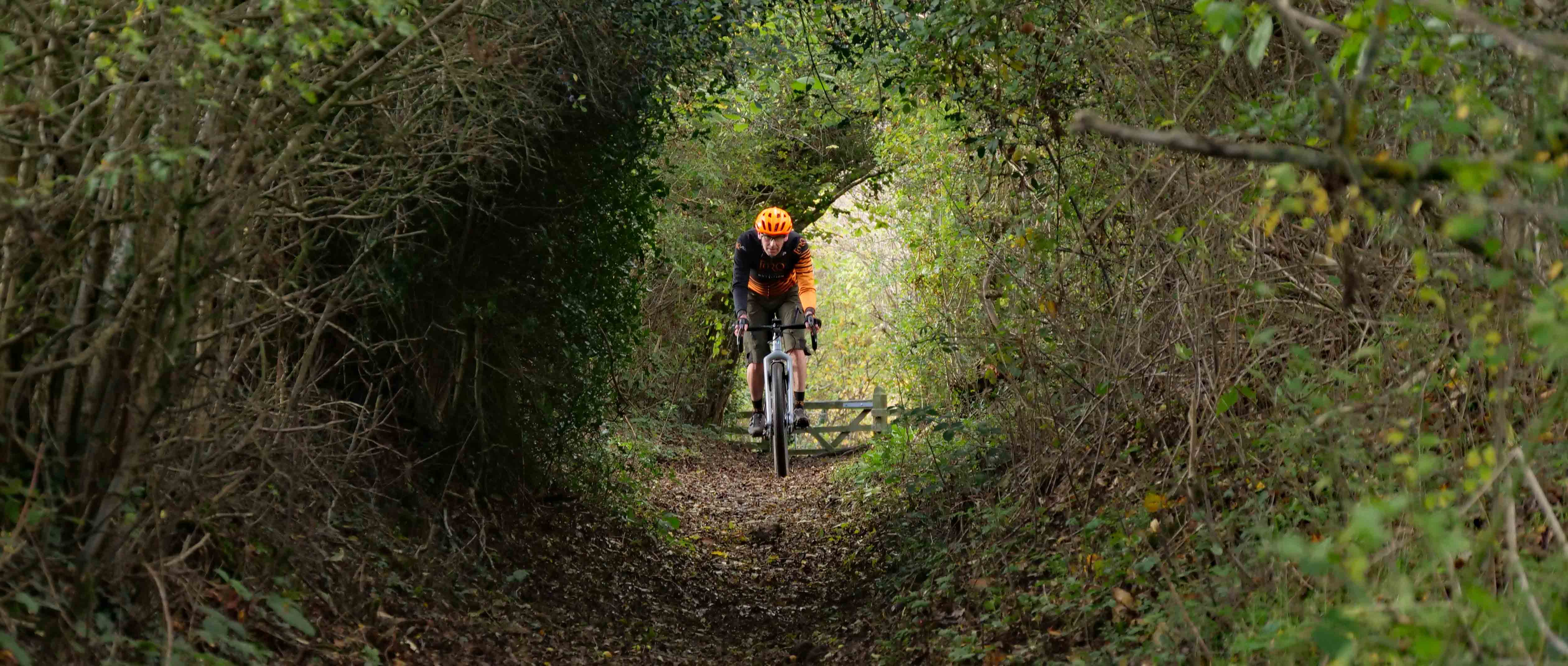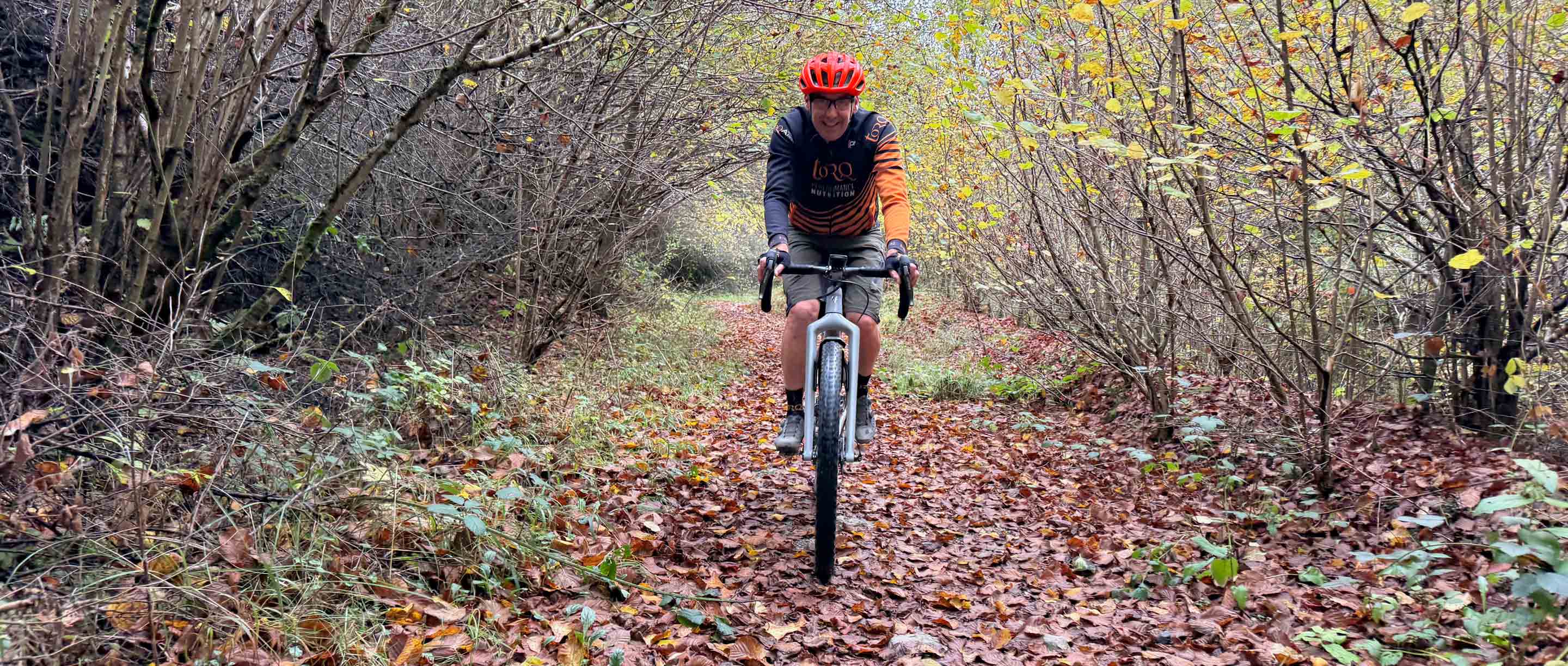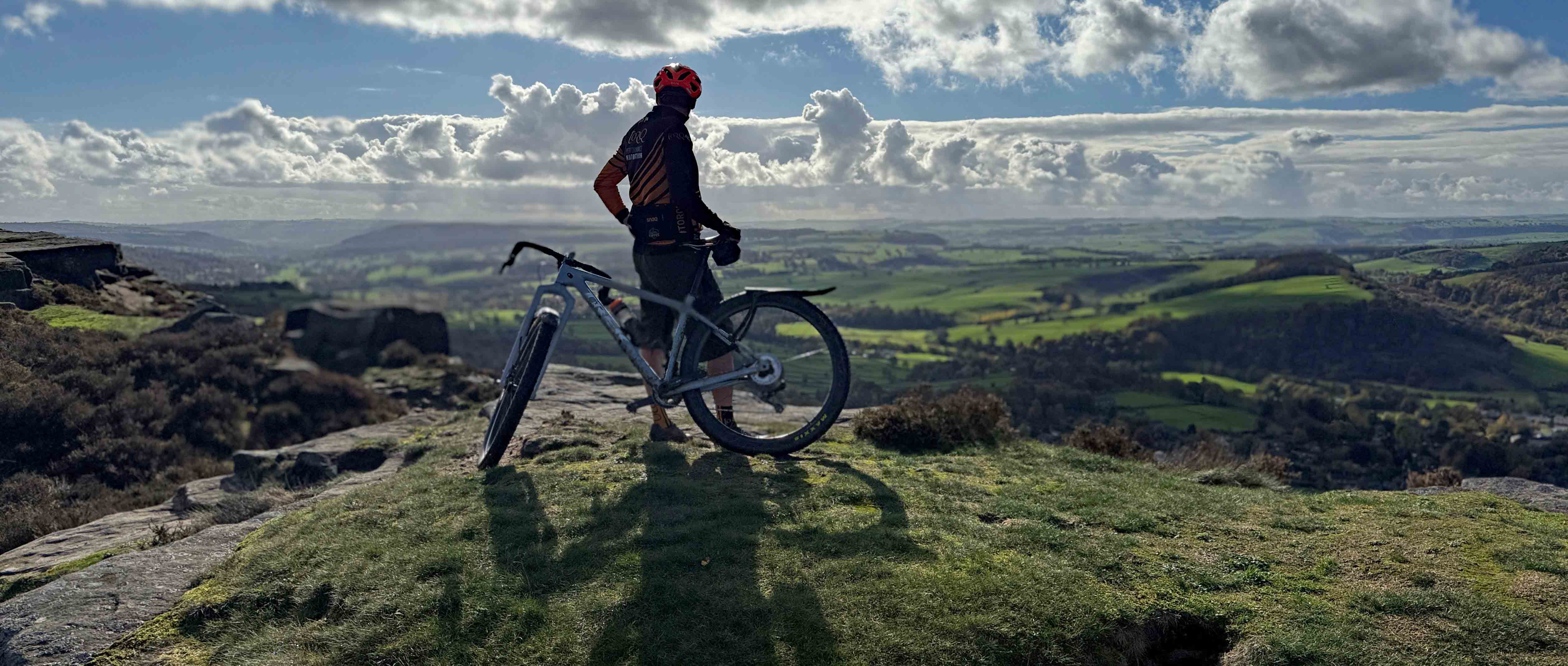Imagine taking one of your friends on their first ever away-from-the-road ride on a drop bar bike. Where would you take them? How gnarly would make the route? What could you do to help them feel more at ease? Now imagine that your friend is a former elite-level XC MTB racer, so they've got a ton of bike skills, but they're used to riding a flat bar bike with 100 mm of suspension. Olly put on his gravel guide uniform and headed to the UK’s Peak District with Matt Hart from Torq, trying to convince him that a drop bar bike was the way forward. How did Matt get on? Read on to find out….

I first started riding in the Peak District in 1993, which makes me feel very old. Don’t tell my long-suffering parents this, but the main reason that I choose to do my undergraduate degree at the nearby University of Derby was more about its proximity to the hills and MTB trails than it was for its record of academic excellence. At the time, mountain bikes had only been available in the UK for less than a decade and the technology was pretty agricultural – no suspension, skinny tyres, narrow handlebars and a rigid seatpost. Although it’s a well-worn trope now, there’s a lot of similarities between the gravel bikes we use now and the MTB I used in the 1990s. Of course now we have tubeless tyres, hydraulic disc brakes, electronic shifting and carbon fibre, so although there are similarities, I still wouldn’t trade my current gravel bike for a 90s MTB.

Matt Hart, the owner of Torq, got into mountain biking around the same time as me. The difference is that the XC MTB racing bug bit him in a big way and he ended up racing at elite level. So, his experience, skills and fitness are unquestionable. When we rode in Sri Lanka together back in March, Matt dropped the conversational bombshell that he had never ridden off-road on a drop bar bike. That instantly set off a large metaphorical light bulb in the head and six months later, we’d finally made our schedules work so that we could meet up in the Peak District for a ride. I’d offered to lend Matt my Trek #monstercross bike for the day. While it could in no way be considered a ‘proper’ gravel bike, I figured it might be the ideal gateway drug to help get Matt interested in drop bar riding.
The Peak District is home to some of the UK’s finest off-road riding. There is an incredible network of trails, encompassing everything from moorland singletrack to ancient drove roads to sinuous woodland trails. When I close my eyes and picture the trails in my brain, the predominant vision I have is of technical, rock-strewn riding. Even on a monstercross bike, the novelty of being constantly battered by rocky trails would soon wear off, so I figured I should seek some expert advice for where the best gravel riding trails could be found. Fortunately, last summer, guide book author Hetty Kingston produced a book called “Gravel Rides Peak District” and seeing as I had a copy sitting on the bookshelf next to my desk, it seemed like the perfect opportunity to try out one of her routes. I wanted to show Matt why the Peaks is so well regarded by cyclists and as soon as I flicked through Hetty’s book I found the perfect route – “Hathersage and the Eastern Edges.” I knew from previous MTB rides there that the eastern side of the region offered the perfect opportunity for some fantastic riding through stunning scenery, so I set a date with Matt and then made some offerings to the weather gods for decent weather. Hetty’s route was a loop which started/finished in the small-but-perfectly-formed town of Hathersage, home to many great cafes and outdoor shops, plus a railway station and trails practically on the doorstep. I tweaked Hetty’s route slightly to make it a little longer and to add in one extra off-road trail at the end, but 95% of what we rode was based on her recommendations.

My monstercross is quite a strange beast – on the day I rode with Matt it was set up with minimally treaded 29x2.4” tyres, it has a 2x11 Shimano Di2 groupset (with a mix of Shimano’s GRX and XT components) and carbon everything – frame, forks, wheels, bars and seatpost. It means it’s decently light, is super capable on terrain that exceeds anything you would normally consider tackling on a standard gravel bike and it rolls really well. But the downside is that the geometry is quite strange – as it’s based on an XC MTB, the top tube is long and the handlebar height is low. We got Matt set-up on it and he did some carpark testing to dial-in the fit, but he realised straight away that the position was very different to the one he was used to “If I ride on the hoods it’s way more stretched and a lot lower than I’m used to. Interestingly, these tyres are also bigger volume than those that I have fitted on my XC MTB” were his comments. He was also going to have rapidly get used to using a 2x set-up and using Shimano Di2, which operate quite differently to his normal flat bar set-up.

Hetty’s route saw us heading out of Hathersage on tarmac, initially descending, before making a sharp right hand turn straight onto quite a steep tarmac climb. The weather forecast for the day looked perfect, but there were distinctly ominous looking clouds bubbling up behind us. There had obviously been plenty of rain in the days before our ride and in the patches where the sunshine hadn’t cut through, the roads had a decidedly greasy feel to them. I made a mental note to take it a little easy on the first off-road descent. After twenty minutes or so of climbing on the road, during which time Matt got the hang of the foibles of my shifter set-up, we turned onto our first off-road trail. It wasn’t rocky by MTB standards, but it was certainly pretty chunky gravel and we instantly had to concentrate and pick decent lines. Matt’s MTB instincts kicked in and he was soon weaving his way up the climb exactly as you would expect a former elite-level racer to do. I scooted on ahead to get some photos and when Matt came into range, to my eye he looked perfect on the bike – he had dropped his elbows, was keeping his head up and pedalling smoothly. Despite his protestations that he felt very stretched, he looked like a natural.
As we crested the summit of the climb we fell off the edge of my mental trail map. This is one of the brilliant things about following a route that someone else has created – you (hopefully) learn a whole bunch of new trails. Our first descent was super-fast and took us down through some broadleaf woodland. The whole of the trail surface was covered in freshly fallen leaves, which made a beautiful crunching sound but also completely covered whatever hazards hid underneath. As I had no prior trail knowledge and was only riding on 45mm tyres I deliberately backed off the speed – “brail” riding is fun up to a point, but I was pretty wary of hitting an unseen trail hazard and suffering a snakebite puncture. I could feel Matt practically buzzing my back tyre – his super good skills dovetailed nicely with the bike and I’m sure if I hadn’t been there he would have gone dramatically faster. After a quick stop to try and capture some of the fantastic colours visible in the leaf litter, we continued down and dropped into the top of the small village of Eyam. The village is famous for the courageous actions taken by its inhabitants during a bubonic plague epidemic in 1665-66. As soon as we arrived on the outskirts of the village I recognized it, but both our route of entry and exit from the village were new to me.

A descent down an ancient and long forgotten sunken track was next. The trail surface was generally good, but at irregularly spaced intervals concrete erosion protection bars had been constructed right across the track. These bars had a step-down on the far side of them which was anything from 30 cm to nearly 1m in height – the first one caught me unawares and only a last-second change of direction prevented me launching off a much bigger drop-off than I would be happy to ride on a gravel. Bike. At the base of the descent we picked up a short section of main road, before turning right onto a track that was again new to me. As we started to climb the ancient Coombs Dale packhorse trail the geology around us changed noticeably. Eyam, just a short distance earlier is situated in what is known as the Dark Peak, but Stoney Middleton, the last village before Coombs Dale, marks the point where the geology changes from coarse sandstone (known as Millstone Grit) to limestone and hence signals the start of the White Peak. This is of little interest to many people, but to gravel riders, it means the conditions under tyre alter dramatically. Millstone Grit, even in the wet, remains remarkably grippy. Limestone, on the other hand, can be lethally slippery.
At the top of the climb we arrived at High Rake, an area which was been extensively mined for lead in the past. As I glanced down at my Wahoo I realised that our next section of the route took us down a trail I used to challenge myself on years earlier. The trail had historically been a narrow, super techy singletrack, which I generally rode as a climb, with contained many rock outcrops and small steps. As the bedrock was limestone in this area, traction had always been at a premium and any occasion when I had managed to ‘clean’ the trail (i.e. ride up it without needing to unclip or dismount) was a noteworthy one. However, I knew from social media posts that over the past few years the trail had been ‘sanitised.’ Gone was the narrow, technical challenge and it its place was a generally smooth and twisty gravel singletrack. While the local MTB community bemoaned the loss, as a descent for gravel bikes it was awesome! I let Matt go first and despite the fact he was riding the trail blind, he absolutely flew – his MTB genes shone through and he left me well behind.
A few kilometres on tiny country lanes was next, before a short section of main road and then a left turn into a farm yard liberally coated in a cow muck/mud amalgam. I could vividly picture what was coming up next, so after giving Matt a brief heads-up about what to expect I flew off down the trail to find a good spot for taking photos. The track feels incredibly ancient and weaves its way across farmland, hemmed in tightly by drystone walls for the first part. I knew that the trail lulled you into a false sense of security, with an initially smooth section turning significantly more gnarly with little warning. Chunks of grease-licked limestone bedrock are intermingled with gnarled roots. As if that wasn’t enough of a hazard, hawthorn hedges enclose the trail, turning it onto a tunnel and dragging at your clothing with their lethally sharp talons. Despite the greasy conditions, Matt nailed the trail and had a big smile on his face. It was the perfect ‘gravel’ trail to take a mountain biker along.

I knew it wasn’t far until our planned lunch stop, but the trail fairies decided a throw a test our way before we could get there. As the trail changed from technical, rocky challenge to woodland singletrack, we spotted an incredibly greasy looking fallen tree lying across the track. The hillside sloped down to our left and the tree was lying at an awkward angle to the trail. If you wanted to try and ride it, not only did you have to do a perfectly timed double wheel lift, but you had to think about the fall of the trail, the greasiness of the old tree and also negotiate the loose, gravelly surface on the far side of the obstacle. It took Matt three attempts to clear it, but to his credit he was determined to try again until he succeeded. A fellow cyclist that we met who was aboard a full-suspension MTB decided to get off and carry his bike over the fallen tree, so the fact that Matt nailed it on a drop bar bike was very impressive.
By some stroke of genius planning our lunch venue was not only on top of a hill (so we would have a post-lunch descent to look forward to), but the sun was shining and it was warm enough to eat outside, even though it was mid-October! Unfortunately after the initial descent we had a challenging climb to take us back into the Dark Peak and a rendezvous with Wellington’s Monument. While the climb wasn’t super-long at just over 1.5 km, it had some sections where the gradient was nearly 20% and the top section included some short gritstone bedrock outcrops to ride up. Fortunately we made it up without revisiting our lunch and the views were spectacular. The weather gods were really smiling at us and the dark clouds of the morning had burned off to reveal blue sky and sunshine.

The gritstone ‘edges’ which typify the eastern margin of the Peak District were in the main part out-of-bounds historically to mountain bikers – they were the domain of rock climbers and hill walkers. That irony that this part of the UK was the crucible of opening up rights of access to the hills courtesy of the 1932 Kinder Trespass was not lost on the local cycling community. Thanks to some incredible advocacy work, one of the huge positive changes since I used to ride there more regularly was that many of the former “walker only” footpaths which head along Frogatt Edge and under Burbage Rocks have now been legally converted to ‘permissive bridleways’, meaning they are legal to access by bike or on horse. Like many riders, I might have *accidentally* strayed onto some of these trails in the past, but you were always wary of meeting people and it always felt sad that we were legally forbidden from accessing the incredible trails that run along the edge of the moors.
While some of the trails are pretty challenging – in places they weave their way around innumerable gritstone outcrops, forcing you to make constant decisions about which line to pick in a game of high-stakes, high-speed gravel-chess, there are also sections of total serenity. Beautifully manicured vehicle width (but, fortunately vehicle-free) crushed limestone trails took us through ancient broadleaf woodland and under towering outcrops of millstone grit. The vast majority of this section of the route was new to me and it was incredible to experience the joy of the riding such brilliant trails 100% legally. Big kudos should be given to groups such as Peak District MTB for their amazing advocacy work which has resulted in the legal growth of the trail network in this part of the world.
As we reached the end of the Burbage Rocks trail, I decided to deviate from Hetty’s recommended descent back into Hathersage and extend our ride a little. My trail knowledge in this area was limited to some super fun, but seriously challenging MTB trails, which I figured would be less-than-ideal for gravel riders, so I did some map research and spotted what looked like an ideal alternative option. Our route started on some miraculously deserted tarmac, before turning off onto a broken farm track. We picked up speed rapidly, hopping the numerous small potholes that dotted the surface. Just as we were reaching terminal velocity, we had to make an abrupt 90 degree left hand turn and onto one of the best surprises of the ride.
The trail, which I’d spotted on the Ordnance Survey map but had never ridden in real life, turned out to be a belter! The opening section looked like a green tunnel. It was clearly extremely ancient and the sunken surface combined with the arched boughs of coppiced hazel and ancient oak trees created a beautiful gravelly corridor. The trail descended at the perfect angle and the surface was remarkably smooth. Great sight-lines meant Matt and I could ride it a decent speed, safe in the knowledge that we would see any obstacles or other trail users before they became a hazard. All too soon we reached the end of the tunnel and the gradient turned against us. A greasy, cambered climb saw our tyres scrabbling for grip, but it was fortunately short and we soon popped out onto a minor backroad. With a super-swift tarmac descent to finish with, we were soon back into Hathersage and heading for the culinary highlight of the day – Coleman’s Deli. This Hathersage institution has been around since 2003 and serves (in my view) the best coffee and cake in town.

Matt is quite well-known for his staunch views on not eating cake in the middle of gravel rides. Fortunately his post-ride cake appreciation was much more positive. Luckily, the quality of his carrot cake meant the Torq gel was a photo prop, rather than actually being necessary! As we made the most of the late afternoon sunshine, we chatted about the ride and what he had thought of riding off-road on drop bars. From the smile on his face while we had been riding, you could easily tell that he was loving the experience. He wasn’t sold on the fit of my monstercross though “I loved it, but if I was going to get a gravel bike of my own, I would want something with shorter reach and higher handlebars.”
That sounds like a pretty positive outcome, even if not 100% successful. We’re already hatching a plan for a future ride. Next time we’ll try him on a more traditional gravel bike and see whether the tweaked fit is enough to convince him 100% that drop-bar off-road riding is the way forward.